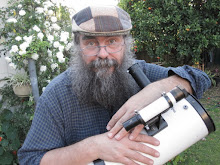Friday, January 17, 2025
The Planetary lineup (or planet parade) of January to February 2025, what will you see
You may have seen the rather breathless statements about the up coming planetary lineup (or planet parade) often illustrated with telescope images of the planets all rather close together and claiming 6-7 planets will be present in the evening sky.
While this is (mostly) true, you won't see anything like the illustrations. The hype distracts from what is a beautiful phenomenon.The planets, only 4 of which are bright dots, are strung out from west to east along the ecliptic like beads on a wire, Jupiter and Mars are bright and in some beautiful night sky territory.
I have some charts and spotting tips below to help you enjoy this without the hype.
| Evening sky on Saturday, January 18 as seen from Adelaide at 21:34 ACDST (60 minutes after sunset, Similar views will be seen from the rest of Australia at roughly the equivalent local time, click to embiggen) | Evening sky on Saturday, January 25 as seen from Adelaide at 21:30 ACDST (60 minutes after sunset, Similar views will be seen from the rest of Australia at roughly the equivalent local time, click to embiggen) | Evening sky on Friday, February 28 as seen from Adelaide at 20:20 ACDST (30 minutes after sunset, Similar views will be seen from the rest of Australia at roughly the equivalent local time, click to embiggen) |
| Orientation of the inner planets on Saturday, January 18 as seen from above the plane of the solar system | Orientation of the inner planets on Saturday, January 25 as seen from above the plane of the solar system | Orientation of the inner planets on Friday, February 28 as seen from above the plane of the solar system |
| Orientation of the outer planets on Saturday, January 18 as seen from above the plane of the solar system | Orientation of the outer planets on Saturday, January 25 as seen from above the plane of the solar system | Orientation of the outer planets on Friday, February 28 as seen from above the plane of the solar system |
Basically, you can only see 4 of the 6-7 with your unaided eye, and rather than all being scrunched up close together, they are spread out over most of the sky from west to north-east.
From the 18th of January to mid February, face west, looking 60 minutes after sunset. Venus is obvious above the western horizon as the brightest object in the sky. Much dimmer Saturn is a spark just above obvious Venus. Turning to the north the next brightest object is golden Jupiter, the second brightest object in the sky after Venus, just below bright red star Aldebaran and the "V" of the Hyades, not far from the delightful Pleiades cluster. Then looking towards the north east, bright red Mars, just past opposition and the third brightest object in the sky, just edging out the bright star Sirius, is lined up with the pair of stars Castor and Pollux, in Gemini. Neptune is telescope visible only and will be difficult to see low on the horizon (see charts above).
Uranus is theoretically unaided eye visible under dark sky sites if you know where to look but is best with binoculars or telescope. Uranus is 3° above delta Ari and roughly halfway between Alpha Ceti and the Pleiades (see chart to the left), it is relatively easy to find in binoculars.The black and white chart suitable for printing shows the location of Uranus, the circle is the approximate field of view of 10x50 binoculars.
The best times to look are between 60 minutes (nautical twilight) and 90 minutes (astronomical twilight, when the sky is fully dark) after sunset, and it helps if you have a clear and level western horizon. Although Venus and Saturn set about 30 minutes or so after astronomical twilight, ~ 2 hours after sunset, trees and houses tend to get in the way.
You should be able to see this lineup from now until around 15 February, when Saturn is too low in the twilight to see (although you should be able to see it with binoculars).
After January the 18th, Saturn draws away from Saturn as the pair lower in the evening twilight. On February the first the crescent Moon is between Saturn and the obvious bright Venus low above the western horizon 60 minutes after sunset. The Moon then goes on to visit all the bright planets in turn over the next few days, this will look very nice . Venus is at its greatest brilliance on the 15th of February.
Although Jupiter and Mars move somewhat over this time they will be roughly where they are on the 18th of January, although Mars is fading rapidly.
Mercury Joins the line up around February the 15th, making 7 planets present, but is hard to see very low in the twilight. By Feb 28 Mercury is higher, but it, Saturn and Neptune are too deep in the twilight to see, and Venus is marginal. Binoculars will be required to see Mercury, and possibly Venus, which is now a thin crescent.
So ignore the hype and head out in the early evening to enjoy the sight as well the constellation of Orion and bright Sirius in Canis Major are there to look at too.
Labels: alignment, binocular, Jupiter, Mars, public outreach, Saturn, unaided eye, Venus














 Click to read about or order
Click to read about or order Click to read about or order
Click to read about or order Click to read about or order
Click to read about or order Click to read about or order
Click to read about or order




